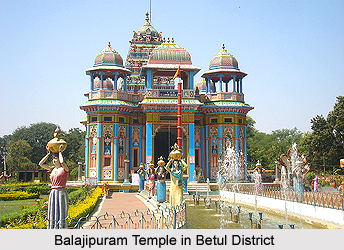 Betul District is one of the marginally located southern districts of Madhya Pradesh lying almost along the Satpura Plateau. The district derives its name from the town of Betul Bazar located at a distance of five kilometres south of Badanur which is the districts headquarter.
Betul District is one of the marginally located southern districts of Madhya Pradesh lying almost along the Satpura Plateau. The district derives its name from the town of Betul Bazar located at a distance of five kilometres south of Badanur which is the districts headquarter.
History of Betul District
During the rule of Maratha Empire, Betul or Betul Bazar was the district Headquarters. In 1822, the District Headquarters was shifted to the present place, then only the village came to be known as Badnur Dhana, meaning Badnur village in the local dialect. Now, even after such a long time, not only the district retains the old name, but the name of the new Headquarters town, Badnur, as also been superimposed by "Betul".
Some of the dynasties, which had ruled Betul in the early days, were Vakataka Dynasty, Rastrakuta Dynasty, Kherala, Sultans of Malwa, Mughal Dynasty, Gonds, and Bhonsle Dynasty and finally the region came under the control of the British East India Company and the British Government.
Geography of Betul District
Betul district forms the southernmost part of the Bhopal Division. The district extends between 21-22 and 22-24 degrees North Latitude and between 77-10 and 78-33 degrees East Longitude. It forms a compact shape, almost a square with slight projection on the East and the West. Two small enclaves of the district, viz., Batla blocks of the Government forests lie to the West between the districts of Nimar (East) and Amaravati. These enclaves lie on the Northern bank of the Tapti River.
Betul district is bounded on the North by Hoshangabad District, on the South by Amaravti of Maharashtra, on the East by Chhindwara District and on the West by the District of Hoshangabad, East Nimar and Amaroti. The Southern boundary of the district runs almost along the southern foothills of the Melghat range, but excludes Hattighat and Chikalda hills in Amarvati district. The Western boundary is associated for some distance with the Ganjal river (Southern), a tributary of Tapti, and then with the watershed line between the Morand and the Ganjal (Northern), the tributaries of the Narmada River. The Northern boundary is marked by the course of the Morand River, and by the Tawa River beyond Dhodra Mohar Railway station. The Eastern Boundary runs through small streams and hills among which Khurpura and Rotia Nalas are of some significance.
Demography of Betul District
In 2011, Population report published by the Goverment of India revealed that the Betul had population of 1,575,247 of which male and female were 799,721 and 775,526 respectively. The average literacy rate of Betul district in 2011 was 70.14 compared to 66.38 of 2001.
Culture of Betul District
The Northern part of the district has a touch of language and culture of Bundelkhand. The Southern belt of the district has overtone of Marathi Language and culture of Maharashtra. The rest of the district is predominantly tribal, populated by the Gond Tribe and Korku Tribe. They worship the god Bada Mahadev. Their rituals are mostly of sacrificial nature. Despite education, they still believe in superstitions. They use natural herbs for their healthcare. There are some institutions for classical Music like, Bhatkhande Sangeet College (in the name of Vishnu Narayan Bhatkhande, one of most notable Indian classical musicologist) at Betul. There is another group amateurs working on various Music Directors from the research angle. An archaeology museum has been working for about fifteen years. There is a small collection of statues and sculptures recently the District Administration have displayed information on the points of historical interests. All over the district are scattered Monuments and relics of historical interests such as Khedla, which was the seat of the Gond Dynasty way back in the 13th century. There are other smaller ports at Asirghad and Bhawarghad in Multai tehsil some caves are found which are supposed to be the hiding place of the Pindaries.
Economy of Betul District
Betul district`s economy is predominantly an agrarian one and due to the large forest cover, it is somewhat also based on forests. Recently there has been some advancement in the industrial sector of Betul due to factors like good road, rail network and Telecommunication facilities. Presently the district of Betul has around 7160 cottage industries, which employ around 17,682 people. There are 33 small scales and a few large scale and medium scale industries in the district of Betul and these industries have been successful in providing employment to the people of Betul to some extent.
Tourism in Betul District
Balajipuram temple is one of the finest temples in Betul District of Madhya Pradesh. This temple is located 8 kilometers from Betul. It is famous for its design and people faith. This is a place of religious value as well as a picnic spot in Betul.
There is another temple called Shri Rukmani Balaji Temple. It is situated at Betul Bazaar, in Betul District. This temple, dedicated to Lord Tirupati Balaji, gives this town a reference name, Balajipuram. The main building of the Shri Rukmani Balaji Temple conforms to the architecture used in South Indian temples. The eminent architects from Southern part of India were involved in the design work. Individual sections in the temple resemble smaller temples, enshrining idols of Lord Ganesha, Lord Krishna and Radha, Goddess Durga and Lord Shiva. The main deity is referred by the name of the God Laxmi Narayan.
There are other temples in Betul like the temples dedicated to Lord Hanuman, Navagraha, and Saint Shirdi Sai Baba. There is an artificial pond named Gangakund, stretching from outside gate to the main building, which contains ten fountains. Another major attraction is a python shaped structure, which actually a tunnel is leading to all the shrines in the complex.






